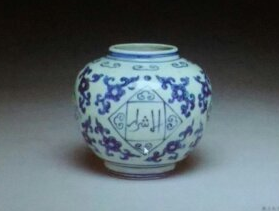Chinese Export Porcelain & Decoration styles
The following are some of the major
Chinese export porcelain types and decorations with foreign or
religious motifs.
Ceramics were a major export item for China since the Sui
(581-618) and Tang dynasties (618-907).
Eearly exports took one of the three following forms:
As a gift to
ambassadors and rulersForeign trade, either
over land or by seaTraders coming to
China for purchasing ceramics
Chinese export porcelain according to destination:
- European export
- Straits export (for Malacca Straits area)
- Bleu de Hué
(for Vietnam)
- Middle Eastern export
- South East Asian and South Asian Export
- Japan
- Buddhist and Islamic decorations (for various
destinations)
Chinese export porcelain for
Europe
- Original Chinese porcelain decoration exported to Europe
- Custom western decoration commissioned via one of the East India Companies
- Armorial porcelain, dinner sets, table wares, etc.
- Decorations like Batavia ware, Grisaille, etc. made specifically for European market (not used in China)
- Chinese porcelain body exported for painting in Europe
- Chinese decoration painted on porcelain made in Europe
South East Asia and South
Asia
Some ancient Kingdoms in South East Asia and South Asia (Sri
Lanka) maintained contact with the Chinese court over extended
period of times, resulting in the export of ceramics and other
products from China to these.
One of these was the yet relatively little known kingdom of
Tondo, in Luzon (Philippines) which was able to trade with
China even during the Ming sea prohibition.
Straits export (Peranakan or
Nyonya porcelain)
Peranakan
porcelain was made exclusively for the Baba Nyonya on both
sides of the Malacca straits. The Baba Nyonya were early
immigrants who emigrated to the Malacca straits area during the
14th and 15th centuries. Influenced by Malay culture theiir
descendants developed an unique local Chinese culture. This
also resulted in an especially colorful style of porcelain. In
the 19th century they began ordering Chinese porcelain
custom-made according to their unique tastes for their
festivities and ceremonies.
Bleu de Hué
Hué was the old capital of what is now Vietnam. The name Bleu
de Hue means a type of underglaze blue porcelain with largely
Chinese motifs, made for the court or nobility in old
Vietnam.
Middle Eastern
Export
Actually, the indirect export to the Middle East began very
early, long before a direct trading routes on land or sea were
established. Ceramics exports to the Persian gulf area by sea
began during the Tang and Song dynasties when longer sea
voyages became feasible.
Export to Japan
A less known export ware is the Chinese porcelain exported to
Japan. The fact that Japan for a time completely replaced China
as the main porcelain supplier to Europe seems to have
obliterated the fact that it imported porcelain from Chinese
kilns as early as the Ming dynasty.
Some items exported to Japan show Chinese character marks
specifically for the Japanese market. For example:
- "五良大甫吴祥瑞造" (eight character mark) - this is Minyao porcelain exported from Jingdezhen (Ming dynasty)
- "吳須赤繪" (four character mark) - exported from the end of the Ming dynasty to the Qing dynasty from Yue Port in Zhangzhou . These wares (so-called "Swatow" wares) have a decoration with prominent red and green colors (Chinese: 紅綠彩瓷盤). They are often erroneously thought to be Japanese porcelain.
 |
Note: Image from a presentation, Southern National Palace Museum, Taiwan |
Writing in a non-Chinese language on a jar.
Decorations of Religious Motifs
Islamic DecorationsIslamic decorations were intended either for Central Asia or
the Middle East. Some such decorations contain include
characters or writings in a Middle Eastern language.
Buddhist Decorations
Buddhist decorations consist usually of Buddhist symbols or
images, often contain lotus flowers, and may also contain
characters or writings in Sanskrit, scriptures, etc.. Most of
these were destined for Southeast Asia, although some went also
to Tibet.
Christian Decorations
Such religious decorations were ordered by the clients in
Europe. These decorations appear more often than not in black
on white ground only.
Daoist Decorations
Daoist decoration consists mainly of Daoist symbols and
trigrams. These items are not specifically made as Chinese
export porcelain. They were produced mostly for the domestic
market, although some such items have gone to
overseas Chinese communities and Japan.
